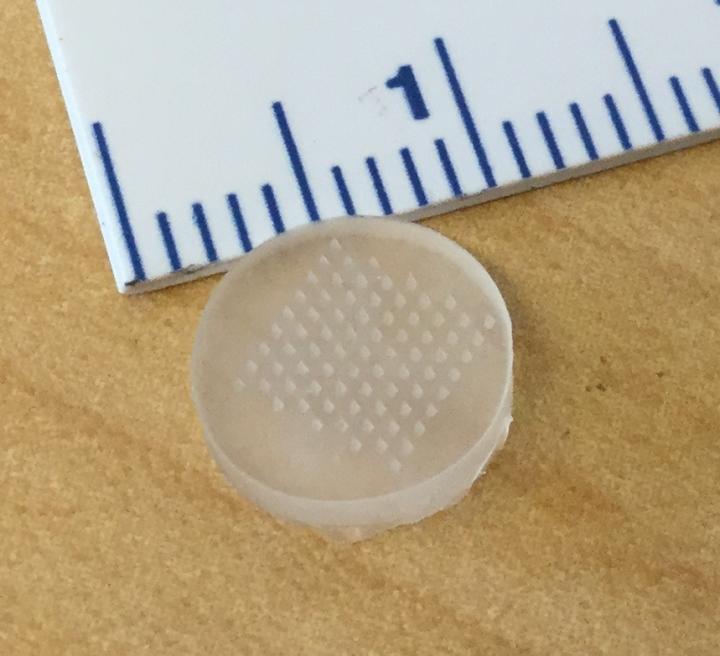
A research team has recently created a microneedle skin patch that can potentially administer vaccines for melanoma and other diseases. This unique solution has demonstrated effectiveness in mice and human skin samples and marks a milestone in the development of a melanoma vaccine. These findings were presented on August 26 at the American Chemical Society (ACS) Fall 2019 National Meeting and Exposition, which featured over 9,500 presentations on various topics.
“Our patch has a unique chemical coating and mode of action that allows it to be applied and removed from the skin in just a minute while still delivering a therapeutic dose of drugs,” explained Yanpu He, a graduate student at the Massachusetts Institute of Technology (MIT) who helped create the patch. “Our patches elicit a robust antibody response in living mice and show promise in eliciting a strong immune response in human skin.”
Although topical ointments can deliver medication to the superficial portion of the skin, they are not effective in getting drugs to the deeper layers. This is typically accomplished with syringes, which are often painful and inconvenient for patients to use. By creating a microneedle patch that painlessly administers drugs to the skin, these researchers have potentially developed a solution to this dilemma.
How the Microneedle Patch Works
The patch is created with a layer-by-layer coating technique, which involves coating the surface of molecules with alternating positive and negative charges. Doing so ensures that the layers are strongly attracted to each other and the microneedle, allowing a significant drug film to form on the patch’s surface. He notes that although this layering creates strong adherence, it comes at a cost.
“But this attraction makes the entire film very ‘sticky,’” He noted. “Past methods, which have retained this ‘sticky’ nature, can take up to 90 minutes for a sufficient amount of drug to leave the patch and enter the skin.”
To combat this, Paula T. Hammond, Ph.D., and her graduate students He, Celestine Hong and others from MIT created a two-part, pH-responsive polymer. One part of this polymer consists of amine groups that yield positive charges in the pH used to create the microneedle but are neutrally charged at the skin’s natural pH. The other part of the polymer contains acid groups that are neutral when the patches are made but bear negative charges when introduced to the skin.
“There is an overall change in charge from positive to negative [when the patch is put on the skin],” explained He.
Though the sticky, layer-by-layer construction is still needed to produce an adequate drug film, these attracting negative-positive-negative layers quickly flip to become repelling negative-negative-negative layers on the skin. Once the microneedles penetrate the wearer’s skin, the drug quickly leaves the patch and enters the targeted area.
READ MORE: Measuring Fetal Heart Rate and Preventing Stillbirths with a Wearable Sensor
Background of the MIT Research
To evaluate the patch’s efficacy in an animal model, the research team vaccinated mice with chicken ovalbumin as the antigen using their microneedle device, intramuscular, and subcutaneous injections. Intramuscular and subcutaneous injections are commonly used to administer flu and measles vaccines, respectively. Hammond and colleagues found that microneedle patch treatment yielded nine times the antibody level as the intramuscular injections, and 160 times that of the subcutaneous injections. Effective activation of the immune system was observed in tissue samples of human skin as well.
“Our patch technology could be used to deliver vaccines to combat different infectious diseases,” Hammond explained. “But we are excited by the possibility that the patch is another tool in the oncologists’ arsenal against cancer, specifically melanoma.”
To create the vaccine, MIT researchers created an antigen that includes a component that is often overexpressed in melanoma cells, as well as an adjuvant to enhance the immune response to this antigen. They then tested different layer-by-layer film arrangements of antigen and adjuvant in the immune cells extracted from the mice. This testing allowed the researchers to identify the best microneedle structure for activating immune cells through the skin.
When administered in vivo, these cells can then enter the lymphatic system and trigger other immune cells to target the malignancy. In their next trials, the scientists plan to evaluate the patches in treating melanoma in mouse models.
“We are using low-cost chemistry and a simple fabrication scheme to transform vaccination. Ultimately, we want to get a device approved and on the market,” concluded Hammond.
Done in 60 seconds: a study from the Hammond lab shows promising results for this microneedle skin patch, used to painlessly deliver a melanoma vaccine in a minute in mice.https://t.co/0E8dS4KiCO pic.twitter.com/IQJYPzrcI5
— Koch Institute at MIT (@kochinstitute) August 27, 2019







 © 2025 Mashup Media, LLC, a Formedics Property. All Rights Reserved.
© 2025 Mashup Media, LLC, a Formedics Property. All Rights Reserved.